Angioedema Management — Practical Steps to Treat Swelling and Prevent Attacks
Sudden swelling of the face, lips, tongue, or throat can be frightening. That’s angioedema — fluid under the skin that can be caused by allergies, drugs like ACE inhibitors, or hereditary problems with Kallikrein/C1‑inhibitor systems. Some attacks are mild and go away; others threaten the airway and need immediate care. Here’s a clear, practical plan you can use right away.
Recognize danger and act fast
What makes angioedema an emergency? Watch for swelling of the tongue, throat tightness, hoarse voice, trouble breathing, drooling, fainting, or noisy breathing (stridor). If you see any of these, call emergency services now. Give intramuscular epinephrine immediately for suspected anaphylaxis — typical adult dose is 0.3–0.5 mg IM; for children it’s about 0.01 mg/kg (use an auto‑injector if available). Sit the person up if they can breathe easier that way and loosen tight clothing. Even after epinephrine, go to the emergency department — dangerous swelling can return hours later.
For milder cases with only localized redness or itch, an oral antihistamine and a cool compress can help. But don’t delay calling for help if swelling spreads or affects the mouth or throat.
Treatment options and long‑term planning
Allergic angioedema usually responds to antihistamines, corticosteroids, and epinephrine when severe. If an allergic trigger is identified (food, insect sting, medicines), avoid it and talk to an allergist about testing and an emergency action plan.
ACE inhibitor–related angioedema can happen days to years after starting the drug. If ACE inhibitors cause swelling, stop the drug and contact your doctor. Don’t switch to another ACE inhibitor; some people can use an ARB, but discuss risks with a clinician first.
Hereditary angioedema (HAE) works differently — it’s bradykinin‑mediated, so antihistamines and steroids usually don’t help. Effective treatments include C1‑esterase inhibitor concentrates, icatibant (a bradykinin B2 receptor blocker), and ecallantide (a kallikrein inhibitor). For frequent attacks, options include lanadelumab, tranexamic acid, or androgen‑based drugs — each has pros and cons, so review them with a specialist.
Practical steps to reduce risk: carry an epinephrine auto‑injector if you’ve had severe allergic reactions, wear a medical ID for known angioedema, keep an attack diary (triggers, food, meds, stress), and tell your dentist or surgeon before procedures. If you have HAE, work with an immunologist to set up on‑demand therapy and preventive treatment for procedures that could trigger an attack.
Finally, always have a clear action plan and discuss it with family or caregivers. Quick recognition and the right medicine can prevent a scary situation from becoming life‑threatening. If airway symptoms appear, get to emergency care immediately.
In my latest blog post, I discussed the crucial role of Betamethasone in managing angioedema. It's a potent steroid that works by reducing inflammation and the body's immune response, which can significantly ease the swelling associated with angioedema. It's usually administered orally or injected, depending on the severity of the condition. However, like any medication, it does have potential side effects, so it's important to use under medical supervision. It's truly fascinating how this medicine can provide relief to those suffering from this often painful condition.

